Fatigue Lifetime Prediction of All-Ceramic Dental Bridges: A Review
VerifiedAdded on 2023/04/04
|8
|2143
|385
Report
AI Summary
This report focuses on the fatigue lifetime prediction of all-ceramic dental bridges, crucial for understanding their clinical performance and longevity. It explores the susceptibility of ceramic prostheses to fracture under repetitive occlusal loading, analyzing failure modes, including those arising from contact zones, cementation surfaces, and margins. The study delves into the underlying mechanisms of fatigue, contrasting chemically-assisted 'slow crack growth' with more deleterious mechanical fatigue mechanisms. It emphasizes the importance of considering mechanical fatigue to avoid overestimating survival rates. The report reviews various ceramic materials like lithium disilicate, zirconia, and polymer-infiltrated ceramics, and investigates the influence of factors such as material properties, loading conditions, and design on bridge performance. The research objectives include predicting the lifetime and loading capacity of all-ceramic bridges, understanding the fatigue behavior of different ceramics, and bridging the knowledge gap between microstructural properties and degradation phenomena. Ultimately, the study aims to provide strategies for prolonging the clinical lifetimes of ceramic restorations based on a crack-containment philosophy, offering valuable insights for dental professionals and material scientists.
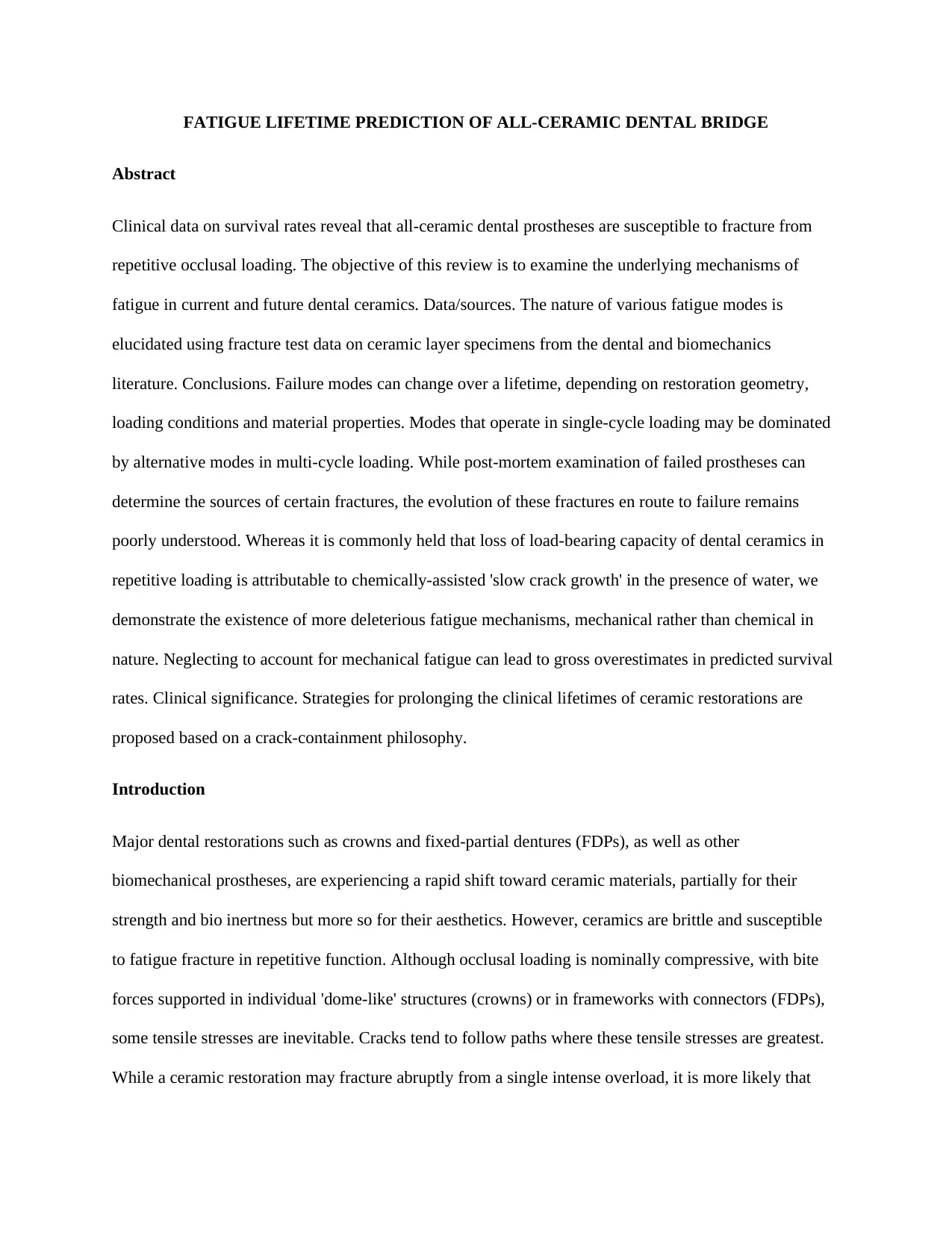
FATIGUE LIFETIME PREDICTION OF ALL-CERAMIC DENTAL BRIDGE
Abstract
Clinical data on survival rates reveal that all-ceramic dental prostheses are susceptible to fracture from
repetitive occlusal loading. The objective of this review is to examine the underlying mechanisms of
fatigue in current and future dental ceramics. Data/sources. The nature of various fatigue modes is
elucidated using fracture test data on ceramic layer specimens from the dental and biomechanics
literature. Conclusions. Failure modes can change over a lifetime, depending on restoration geometry,
loading conditions and material properties. Modes that operate in single-cycle loading may be dominated
by alternative modes in multi-cycle loading. While post-mortem examination of failed prostheses can
determine the sources of certain fractures, the evolution of these fractures en route to failure remains
poorly understood. Whereas it is commonly held that loss of load-bearing capacity of dental ceramics in
repetitive loading is attributable to chemically-assisted 'slow crack growth' in the presence of water, we
demonstrate the existence of more deleterious fatigue mechanisms, mechanical rather than chemical in
nature. Neglecting to account for mechanical fatigue can lead to gross overestimates in predicted survival
rates. Clinical significance. Strategies for prolonging the clinical lifetimes of ceramic restorations are
proposed based on a crack-containment philosophy.
Introduction
Major dental restorations such as crowns and fixed-partial dentures (FDPs), as well as other
biomechanical prostheses, are experiencing a rapid shift toward ceramic materials, partially for their
strength and bio inertness but more so for their aesthetics. However, ceramics are brittle and susceptible
to fatigue fracture in repetitive function. Although occlusal loading is nominally compressive, with bite
forces supported in individual 'dome-like' structures (crowns) or in frameworks with connectors (FDPs),
some tensile stresses are inevitable. Cracks tend to follow paths where these tensile stresses are greatest.
While a ceramic restoration may fracture abruptly from a single intense overload, it is more likely that
Abstract
Clinical data on survival rates reveal that all-ceramic dental prostheses are susceptible to fracture from
repetitive occlusal loading. The objective of this review is to examine the underlying mechanisms of
fatigue in current and future dental ceramics. Data/sources. The nature of various fatigue modes is
elucidated using fracture test data on ceramic layer specimens from the dental and biomechanics
literature. Conclusions. Failure modes can change over a lifetime, depending on restoration geometry,
loading conditions and material properties. Modes that operate in single-cycle loading may be dominated
by alternative modes in multi-cycle loading. While post-mortem examination of failed prostheses can
determine the sources of certain fractures, the evolution of these fractures en route to failure remains
poorly understood. Whereas it is commonly held that loss of load-bearing capacity of dental ceramics in
repetitive loading is attributable to chemically-assisted 'slow crack growth' in the presence of water, we
demonstrate the existence of more deleterious fatigue mechanisms, mechanical rather than chemical in
nature. Neglecting to account for mechanical fatigue can lead to gross overestimates in predicted survival
rates. Clinical significance. Strategies for prolonging the clinical lifetimes of ceramic restorations are
proposed based on a crack-containment philosophy.
Introduction
Major dental restorations such as crowns and fixed-partial dentures (FDPs), as well as other
biomechanical prostheses, are experiencing a rapid shift toward ceramic materials, partially for their
strength and bio inertness but more so for their aesthetics. However, ceramics are brittle and susceptible
to fatigue fracture in repetitive function. Although occlusal loading is nominally compressive, with bite
forces supported in individual 'dome-like' structures (crowns) or in frameworks with connectors (FDPs),
some tensile stresses are inevitable. Cracks tend to follow paths where these tensile stresses are greatest.
While a ceramic restoration may fracture abruptly from a single intense overload, it is more likely that
Paraphrase This Document
Need a fresh take? Get an instant paraphrase of this document with our AI Paraphraser
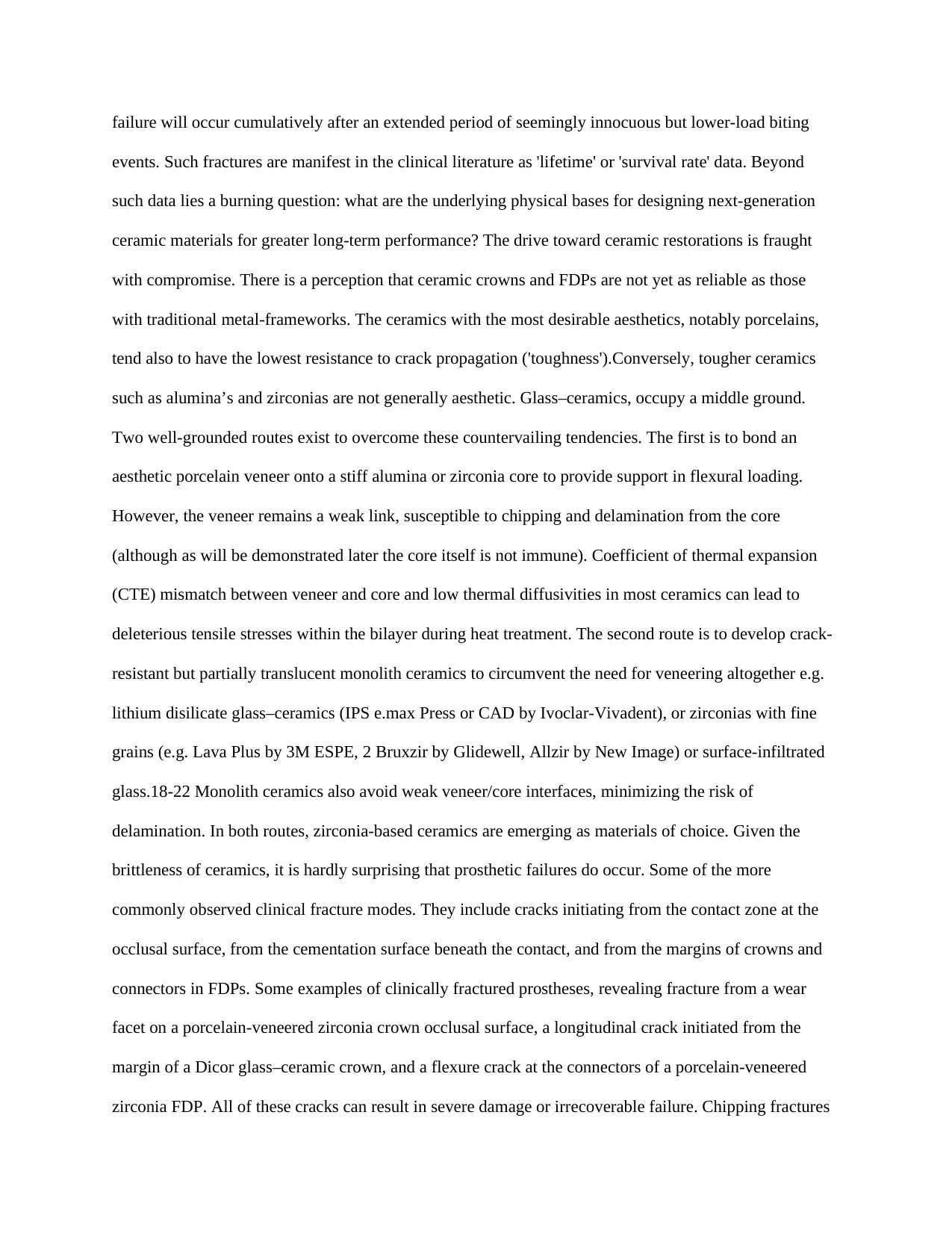
failure will occur cumulatively after an extended period of seemingly innocuous but lower-load biting
events. Such fractures are manifest in the clinical literature as 'lifetime' or 'survival rate' data. Beyond
such data lies a burning question: what are the underlying physical bases for designing next-generation
ceramic materials for greater long-term performance? The drive toward ceramic restorations is fraught
with compromise. There is a perception that ceramic crowns and FDPs are not yet as reliable as those
with traditional metal-frameworks. The ceramics with the most desirable aesthetics, notably porcelains,
tend also to have the lowest resistance to crack propagation ('toughness').Conversely, tougher ceramics
such as alumina’s and zirconias are not generally aesthetic. Glass–ceramics, occupy a middle ground.
Two well-grounded routes exist to overcome these countervailing tendencies. The first is to bond an
aesthetic porcelain veneer onto a stiff alumina or zirconia core to provide support in flexural loading.
However, the veneer remains a weak link, susceptible to chipping and delamination from the core
(although as will be demonstrated later the core itself is not immune). Coefficient of thermal expansion
(CTE) mismatch between veneer and core and low thermal diffusivities in most ceramics can lead to
deleterious tensile stresses within the bilayer during heat treatment. The second route is to develop crack-
resistant but partially translucent monolith ceramics to circumvent the need for veneering altogether e.g.
lithium disilicate glass–ceramics (IPS e.max Press or CAD by Ivoclar-Vivadent), or zirconias with fine
grains (e.g. Lava Plus by 3M ESPE, 2 Bruxzir by Glidewell, Allzir by New Image) or surface-infiltrated
glass.18-22 Monolith ceramics also avoid weak veneer/core interfaces, minimizing the risk of
delamination. In both routes, zirconia-based ceramics are emerging as materials of choice. Given the
brittleness of ceramics, it is hardly surprising that prosthetic failures do occur. Some of the more
commonly observed clinical fracture modes. They include cracks initiating from the contact zone at the
occlusal surface, from the cementation surface beneath the contact, and from the margins of crowns and
connectors in FDPs. Some examples of clinically fractured prostheses, revealing fracture from a wear
facet on a porcelain-veneered zirconia crown occlusal surface, a longitudinal crack initiated from the
margin of a Dicor glass–ceramic crown, and a flexure crack at the connectors of a porcelain-veneered
zirconia FDP. All of these cracks can result in severe damage or irrecoverable failure. Chipping fractures
events. Such fractures are manifest in the clinical literature as 'lifetime' or 'survival rate' data. Beyond
such data lies a burning question: what are the underlying physical bases for designing next-generation
ceramic materials for greater long-term performance? The drive toward ceramic restorations is fraught
with compromise. There is a perception that ceramic crowns and FDPs are not yet as reliable as those
with traditional metal-frameworks. The ceramics with the most desirable aesthetics, notably porcelains,
tend also to have the lowest resistance to crack propagation ('toughness').Conversely, tougher ceramics
such as alumina’s and zirconias are not generally aesthetic. Glass–ceramics, occupy a middle ground.
Two well-grounded routes exist to overcome these countervailing tendencies. The first is to bond an
aesthetic porcelain veneer onto a stiff alumina or zirconia core to provide support in flexural loading.
However, the veneer remains a weak link, susceptible to chipping and delamination from the core
(although as will be demonstrated later the core itself is not immune). Coefficient of thermal expansion
(CTE) mismatch between veneer and core and low thermal diffusivities in most ceramics can lead to
deleterious tensile stresses within the bilayer during heat treatment. The second route is to develop crack-
resistant but partially translucent monolith ceramics to circumvent the need for veneering altogether e.g.
lithium disilicate glass–ceramics (IPS e.max Press or CAD by Ivoclar-Vivadent), or zirconias with fine
grains (e.g. Lava Plus by 3M ESPE, 2 Bruxzir by Glidewell, Allzir by New Image) or surface-infiltrated
glass.18-22 Monolith ceramics also avoid weak veneer/core interfaces, minimizing the risk of
delamination. In both routes, zirconia-based ceramics are emerging as materials of choice. Given the
brittleness of ceramics, it is hardly surprising that prosthetic failures do occur. Some of the more
commonly observed clinical fracture modes. They include cracks initiating from the contact zone at the
occlusal surface, from the cementation surface beneath the contact, and from the margins of crowns and
connectors in FDPs. Some examples of clinically fractured prostheses, revealing fracture from a wear
facet on a porcelain-veneered zirconia crown occlusal surface, a longitudinal crack initiated from the
margin of a Dicor glass–ceramic crown, and a flexure crack at the connectors of a porcelain-veneered
zirconia FDP. All of these cracks can result in severe damage or irrecoverable failure. Chipping fractures

initiate from contact damage sites and detach at least part of the veneer from the core. Through-thickness
fractures initiate from the occlusal or cementation surface beneath the contact or from the margins or
connectors and can split a prosthesis in two. Clinical trials reporting survival rates for several all-ceramic
systems indicate vulnerabilities to all these fractures. Broadly speaking, porcelain-veneered systems show
higher fracture rates than full-contour monoliths, FDPs more than single crowns, and glass– ceramic more
than zirconia monoliths, although the variability in data from study to study can be high. The physical
mechanisms of fatigue in ceramic restorative materials have not been well documented in the dental
literature. The prevailing view, borrowed originally from fundamental studies in the materials science
community, is that fatigue can be accounted for by chemically-enhanced, rate-dependent crack growth in
the presence of moisture. According to this viewpoint, water enters incipient fissures and breaks down
cohesive bonds holding the crack walls together. The result is so-called 'subcritical' or 'slow' crack growth
(SCG) which progresses steadily over time, accelerating at higher stress levels and ultimately leading to
failure. The notion is attractive because it lends itself to rigorous 'fracture mechanics' analysis in terms of
3 explicit crack velocity equations, enabling one to predict lifetimes in terms of specified stress states. But
recent studies in the materials science arena reveal that fatigue is more complex than just SCG. In
addition to chemical degradation, there are mechanisms of mechanical degradation that can augment the
fatigue process. Mechanical fatigue operates exclusively in cyclic loading and cannot be inferred from
static or monotonic loading tests. It can be relatively destructive, meaning that predictions based
exclusively on SCG assumptions may grossly overestimate potential lifetimes. 'Fractography' the
microscopic analysis of post-failure restorations—can point to likely starting sources of fracture but is
limited in its capacity to shed light on the fatigue mechanisms themselves, or to determine the sometimes
complex evolutionary progression of competing fractures to completion.
1. Background
The ceramic materials have advanced from their conventional purpose to create glass and clay
products. At present, the ceramics are used in daily life like in application of aerospace, automotive,
fractures initiate from the occlusal or cementation surface beneath the contact or from the margins or
connectors and can split a prosthesis in two. Clinical trials reporting survival rates for several all-ceramic
systems indicate vulnerabilities to all these fractures. Broadly speaking, porcelain-veneered systems show
higher fracture rates than full-contour monoliths, FDPs more than single crowns, and glass– ceramic more
than zirconia monoliths, although the variability in data from study to study can be high. The physical
mechanisms of fatigue in ceramic restorative materials have not been well documented in the dental
literature. The prevailing view, borrowed originally from fundamental studies in the materials science
community, is that fatigue can be accounted for by chemically-enhanced, rate-dependent crack growth in
the presence of moisture. According to this viewpoint, water enters incipient fissures and breaks down
cohesive bonds holding the crack walls together. The result is so-called 'subcritical' or 'slow' crack growth
(SCG) which progresses steadily over time, accelerating at higher stress levels and ultimately leading to
failure. The notion is attractive because it lends itself to rigorous 'fracture mechanics' analysis in terms of
3 explicit crack velocity equations, enabling one to predict lifetimes in terms of specified stress states. But
recent studies in the materials science arena reveal that fatigue is more complex than just SCG. In
addition to chemical degradation, there are mechanisms of mechanical degradation that can augment the
fatigue process. Mechanical fatigue operates exclusively in cyclic loading and cannot be inferred from
static or monotonic loading tests. It can be relatively destructive, meaning that predictions based
exclusively on SCG assumptions may grossly overestimate potential lifetimes. 'Fractography' the
microscopic analysis of post-failure restorations—can point to likely starting sources of fracture but is
limited in its capacity to shed light on the fatigue mechanisms themselves, or to determine the sometimes
complex evolutionary progression of competing fractures to completion.
1. Background
The ceramic materials have advanced from their conventional purpose to create glass and clay
products. At present, the ceramics are used in daily life like in application of aerospace, automotive,
⊘ This is a preview!⊘
Do you want full access?
Subscribe today to unlock all pages.

Trusted by 1+ million students worldwide
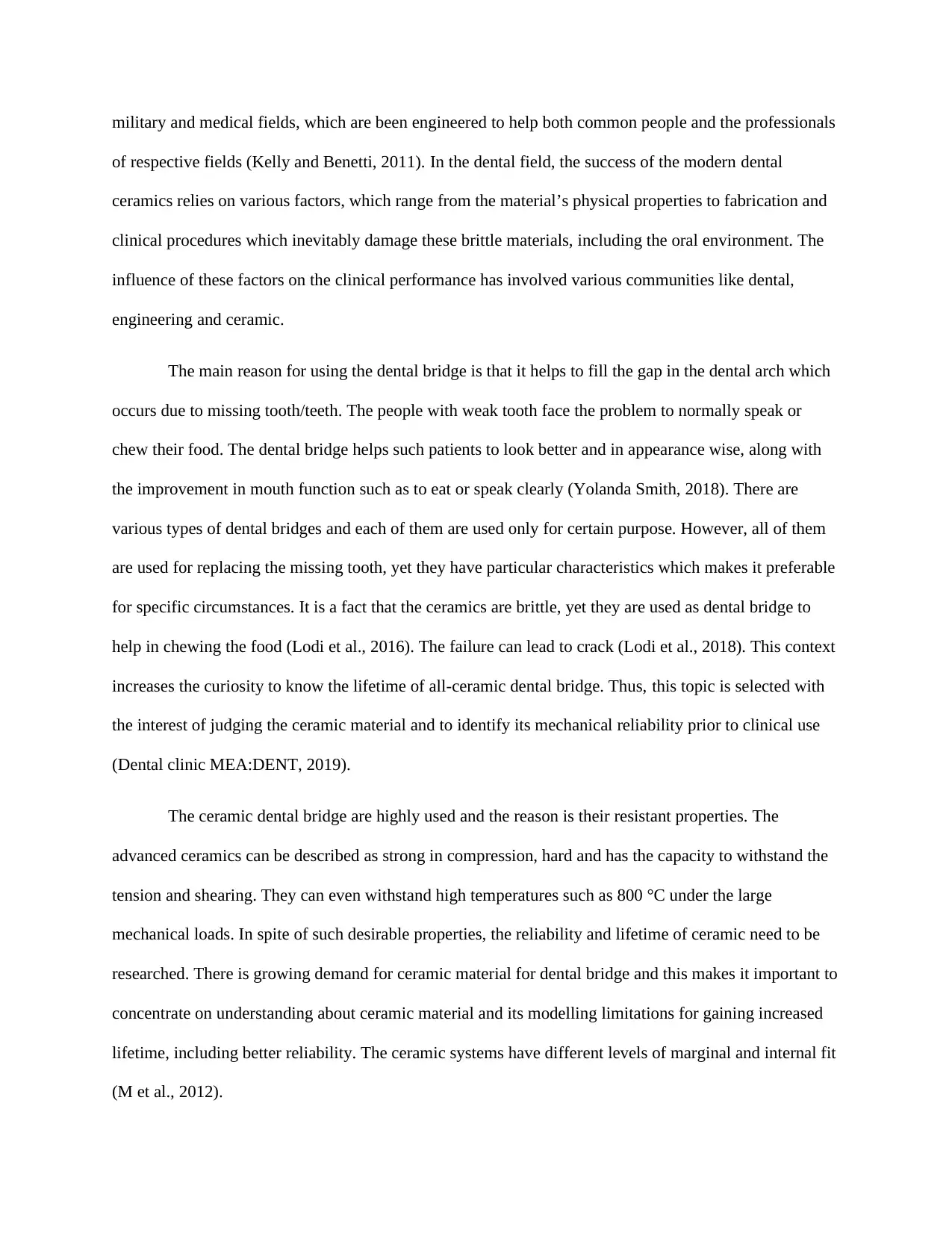
military and medical fields, which are been engineered to help both common people and the professionals
of respective fields (Kelly and Benetti, 2011). In the dental field, the success of the modern dental
ceramics relies on various factors, which range from the material’s physical properties to fabrication and
clinical procedures which inevitably damage these brittle materials, including the oral environment. The
influence of these factors on the clinical performance has involved various communities like dental,
engineering and ceramic.
The main reason for using the dental bridge is that it helps to fill the gap in the dental arch which
occurs due to missing tooth/teeth. The people with weak tooth face the problem to normally speak or
chew their food. The dental bridge helps such patients to look better and in appearance wise, along with
the improvement in mouth function such as to eat or speak clearly (Yolanda Smith, 2018). There are
various types of dental bridges and each of them are used only for certain purpose. However, all of them
are used for replacing the missing tooth, yet they have particular characteristics which makes it preferable
for specific circumstances. It is a fact that the ceramics are brittle, yet they are used as dental bridge to
help in chewing the food (Lodi et al., 2016). The failure can lead to crack (Lodi et al., 2018). This context
increases the curiosity to know the lifetime of all-ceramic dental bridge. Thus, this topic is selected with
the interest of judging the ceramic material and to identify its mechanical reliability prior to clinical use
(Dental clinic MEA:DENT, 2019).
The ceramic dental bridge are highly used and the reason is their resistant properties. The
advanced ceramics can be described as strong in compression, hard and has the capacity to withstand the
tension and shearing. They can even withstand high temperatures such as 800 °C under the large
mechanical loads. In spite of such desirable properties, the reliability and lifetime of ceramic need to be
researched. There is growing demand for ceramic material for dental bridge and this makes it important to
concentrate on understanding about ceramic material and its modelling limitations for gaining increased
lifetime, including better reliability. The ceramic systems have different levels of marginal and internal fit
(M et al., 2012).
of respective fields (Kelly and Benetti, 2011). In the dental field, the success of the modern dental
ceramics relies on various factors, which range from the material’s physical properties to fabrication and
clinical procedures which inevitably damage these brittle materials, including the oral environment. The
influence of these factors on the clinical performance has involved various communities like dental,
engineering and ceramic.
The main reason for using the dental bridge is that it helps to fill the gap in the dental arch which
occurs due to missing tooth/teeth. The people with weak tooth face the problem to normally speak or
chew their food. The dental bridge helps such patients to look better and in appearance wise, along with
the improvement in mouth function such as to eat or speak clearly (Yolanda Smith, 2018). There are
various types of dental bridges and each of them are used only for certain purpose. However, all of them
are used for replacing the missing tooth, yet they have particular characteristics which makes it preferable
for specific circumstances. It is a fact that the ceramics are brittle, yet they are used as dental bridge to
help in chewing the food (Lodi et al., 2016). The failure can lead to crack (Lodi et al., 2018). This context
increases the curiosity to know the lifetime of all-ceramic dental bridge. Thus, this topic is selected with
the interest of judging the ceramic material and to identify its mechanical reliability prior to clinical use
(Dental clinic MEA:DENT, 2019).
The ceramic dental bridge are highly used and the reason is their resistant properties. The
advanced ceramics can be described as strong in compression, hard and has the capacity to withstand the
tension and shearing. They can even withstand high temperatures such as 800 °C under the large
mechanical loads. In spite of such desirable properties, the reliability and lifetime of ceramic need to be
researched. There is growing demand for ceramic material for dental bridge and this makes it important to
concentrate on understanding about ceramic material and its modelling limitations for gaining increased
lifetime, including better reliability. The ceramic systems have different levels of marginal and internal fit
(M et al., 2012).
Paraphrase This Document
Need a fresh take? Get an instant paraphrase of this document with our AI Paraphraser
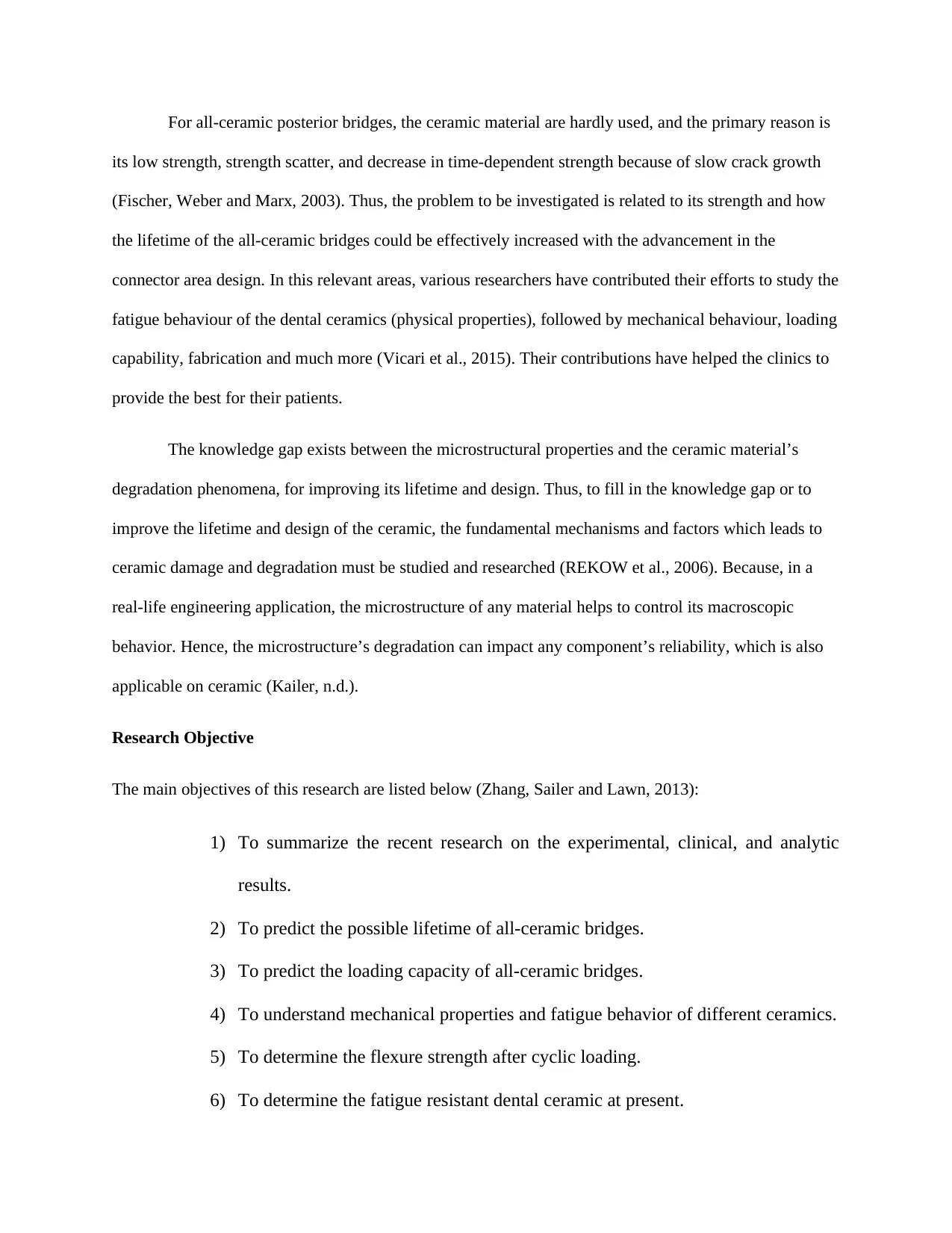
For all-ceramic posterior bridges, the ceramic material are hardly used, and the primary reason is
its low strength, strength scatter, and decrease in time-dependent strength because of slow crack growth
(Fischer, Weber and Marx, 2003). Thus, the problem to be investigated is related to its strength and how
the lifetime of the all-ceramic bridges could be effectively increased with the advancement in the
connector area design. In this relevant areas, various researchers have contributed their efforts to study the
fatigue behaviour of the dental ceramics (physical properties), followed by mechanical behaviour, loading
capability, fabrication and much more (Vicari et al., 2015). Their contributions have helped the clinics to
provide the best for their patients.
The knowledge gap exists between the microstructural properties and the ceramic material’s
degradation phenomena, for improving its lifetime and design. Thus, to fill in the knowledge gap or to
improve the lifetime and design of the ceramic, the fundamental mechanisms and factors which leads to
ceramic damage and degradation must be studied and researched (REKOW et al., 2006). Because, in a
real-life engineering application, the microstructure of any material helps to control its macroscopic
behavior. Hence, the microstructure’s degradation can impact any component’s reliability, which is also
applicable on ceramic (Kailer, n.d.).
Research Objective
The main objectives of this research are listed below (Zhang, Sailer and Lawn, 2013):
1) To summarize the recent research on the experimental, clinical, and analytic
results.
2) To predict the possible lifetime of all-ceramic bridges.
3) To predict the loading capacity of all-ceramic bridges.
4) To understand mechanical properties and fatigue behavior of different ceramics.
5) To determine the flexure strength after cyclic loading.
6) To determine the fatigue resistant dental ceramic at present.
its low strength, strength scatter, and decrease in time-dependent strength because of slow crack growth
(Fischer, Weber and Marx, 2003). Thus, the problem to be investigated is related to its strength and how
the lifetime of the all-ceramic bridges could be effectively increased with the advancement in the
connector area design. In this relevant areas, various researchers have contributed their efforts to study the
fatigue behaviour of the dental ceramics (physical properties), followed by mechanical behaviour, loading
capability, fabrication and much more (Vicari et al., 2015). Their contributions have helped the clinics to
provide the best for their patients.
The knowledge gap exists between the microstructural properties and the ceramic material’s
degradation phenomena, for improving its lifetime and design. Thus, to fill in the knowledge gap or to
improve the lifetime and design of the ceramic, the fundamental mechanisms and factors which leads to
ceramic damage and degradation must be studied and researched (REKOW et al., 2006). Because, in a
real-life engineering application, the microstructure of any material helps to control its macroscopic
behavior. Hence, the microstructure’s degradation can impact any component’s reliability, which is also
applicable on ceramic (Kailer, n.d.).
Research Objective
The main objectives of this research are listed below (Zhang, Sailer and Lawn, 2013):
1) To summarize the recent research on the experimental, clinical, and analytic
results.
2) To predict the possible lifetime of all-ceramic bridges.
3) To predict the loading capacity of all-ceramic bridges.
4) To understand mechanical properties and fatigue behavior of different ceramics.
5) To determine the flexure strength after cyclic loading.
6) To determine the fatigue resistant dental ceramic at present.
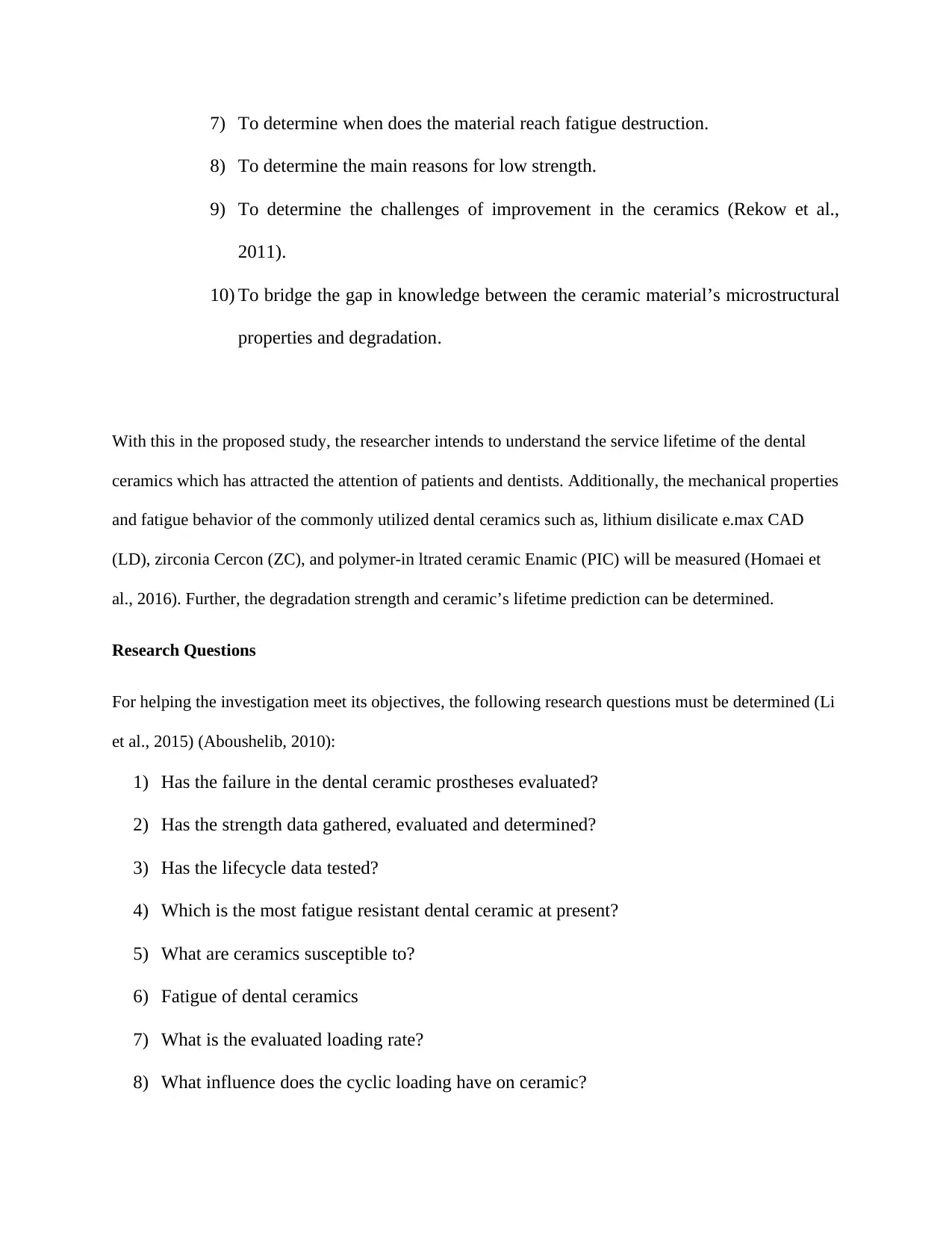
7) To determine when does the material reach fatigue destruction.
8) To determine the main reasons for low strength.
9) To determine the challenges of improvement in the ceramics (Rekow et al.,
2011).
10) To bridge the gap in knowledge between the ceramic material’s microstructural
properties and degradation.
With this in the proposed study, the researcher intends to understand the service lifetime of the dental
ceramics which has attracted the attention of patients and dentists. Additionally, the mechanical properties
and fatigue behavior of the commonly utilized dental ceramics such as, lithium disilicate e.max CAD
(LD), zirconia Cercon (ZC), and polymer-in ltrated ceramic Enamic (PIC) will be measured (Homaei et
al., 2016). Further, the degradation strength and ceramic’s lifetime prediction can be determined.
Research Questions
For helping the investigation meet its objectives, the following research questions must be determined (Li
et al., 2015) (Aboushelib, 2010):
1) Has the failure in the dental ceramic prostheses evaluated?
2) Has the strength data gathered, evaluated and determined?
3) Has the lifecycle data tested?
4) Which is the most fatigue resistant dental ceramic at present?
5) What are ceramics susceptible to?
6) Fatigue of dental ceramics
7) What is the evaluated loading rate?
8) What influence does the cyclic loading have on ceramic?
8) To determine the main reasons for low strength.
9) To determine the challenges of improvement in the ceramics (Rekow et al.,
2011).
10) To bridge the gap in knowledge between the ceramic material’s microstructural
properties and degradation.
With this in the proposed study, the researcher intends to understand the service lifetime of the dental
ceramics which has attracted the attention of patients and dentists. Additionally, the mechanical properties
and fatigue behavior of the commonly utilized dental ceramics such as, lithium disilicate e.max CAD
(LD), zirconia Cercon (ZC), and polymer-in ltrated ceramic Enamic (PIC) will be measured (Homaei et
al., 2016). Further, the degradation strength and ceramic’s lifetime prediction can be determined.
Research Questions
For helping the investigation meet its objectives, the following research questions must be determined (Li
et al., 2015) (Aboushelib, 2010):
1) Has the failure in the dental ceramic prostheses evaluated?
2) Has the strength data gathered, evaluated and determined?
3) Has the lifecycle data tested?
4) Which is the most fatigue resistant dental ceramic at present?
5) What are ceramics susceptible to?
6) Fatigue of dental ceramics
7) What is the evaluated loading rate?
8) What influence does the cyclic loading have on ceramic?
⊘ This is a preview!⊘
Do you want full access?
Subscribe today to unlock all pages.

Trusted by 1+ million students worldwide
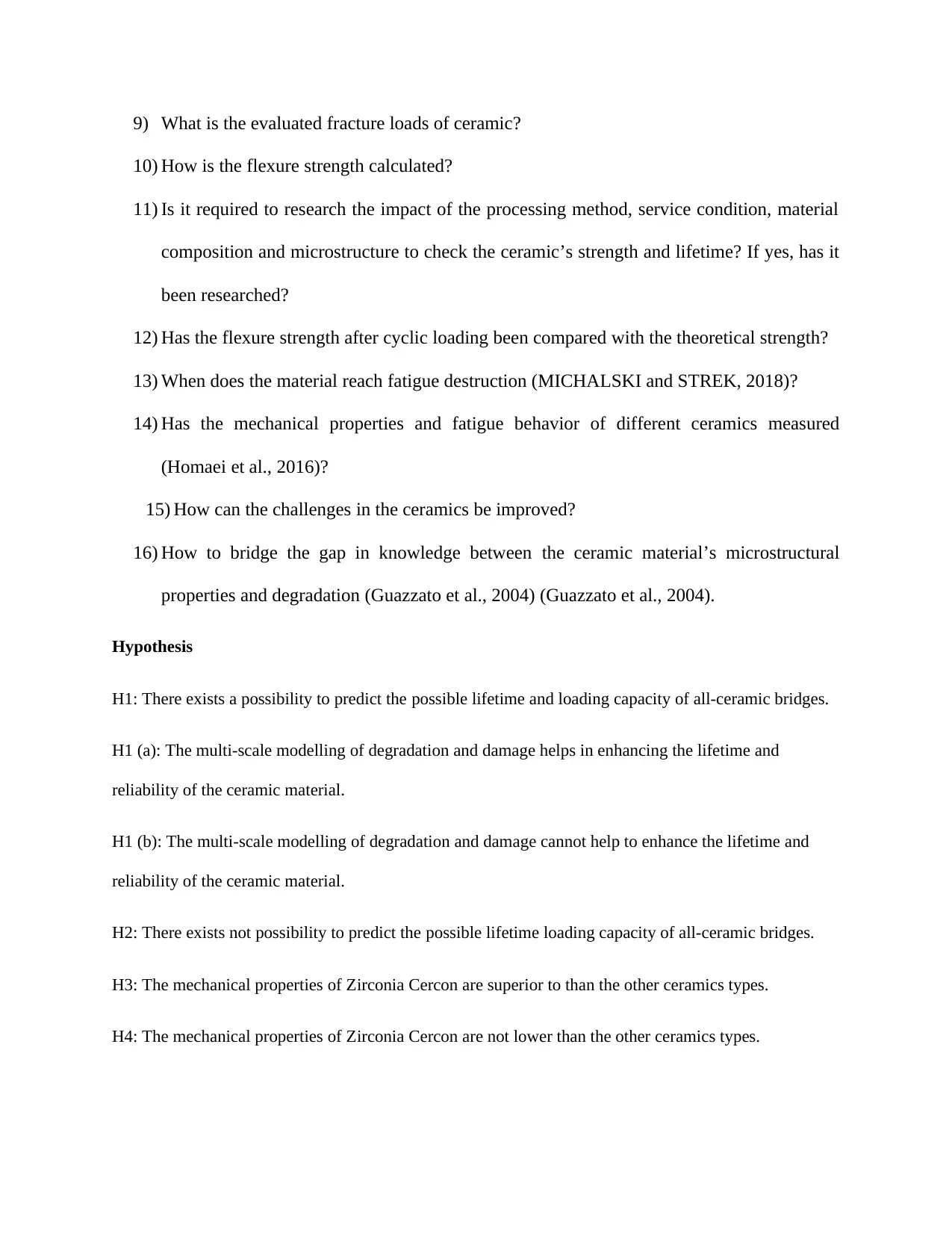
9) What is the evaluated fracture loads of ceramic?
10) How is the flexure strength calculated?
11) Is it required to research the impact of the processing method, service condition, material
composition and microstructure to check the ceramic’s strength and lifetime? If yes, has it
been researched?
12) Has the flexure strength after cyclic loading been compared with the theoretical strength?
13) When does the material reach fatigue destruction (MICHALSKI and STREK, 2018)?
14) Has the mechanical properties and fatigue behavior of different ceramics measured
(Homaei et al., 2016)?
15) How can the challenges in the ceramics be improved?
16) How to bridge the gap in knowledge between the ceramic material’s microstructural
properties and degradation (Guazzato et al., 2004) (Guazzato et al., 2004).
Hypothesis
H1: There exists a possibility to predict the possible lifetime and loading capacity of all-ceramic bridges.
H1 (a): The multi-scale modelling of degradation and damage helps in enhancing the lifetime and
reliability of the ceramic material.
H1 (b): The multi-scale modelling of degradation and damage cannot help to enhance the lifetime and
reliability of the ceramic material.
H2: There exists not possibility to predict the possible lifetime loading capacity of all-ceramic bridges.
H3: The mechanical properties of Zirconia Cercon are superior to than the other ceramics types.
H4: The mechanical properties of Zirconia Cercon are not lower than the other ceramics types.
10) How is the flexure strength calculated?
11) Is it required to research the impact of the processing method, service condition, material
composition and microstructure to check the ceramic’s strength and lifetime? If yes, has it
been researched?
12) Has the flexure strength after cyclic loading been compared with the theoretical strength?
13) When does the material reach fatigue destruction (MICHALSKI and STREK, 2018)?
14) Has the mechanical properties and fatigue behavior of different ceramics measured
(Homaei et al., 2016)?
15) How can the challenges in the ceramics be improved?
16) How to bridge the gap in knowledge between the ceramic material’s microstructural
properties and degradation (Guazzato et al., 2004) (Guazzato et al., 2004).
Hypothesis
H1: There exists a possibility to predict the possible lifetime and loading capacity of all-ceramic bridges.
H1 (a): The multi-scale modelling of degradation and damage helps in enhancing the lifetime and
reliability of the ceramic material.
H1 (b): The multi-scale modelling of degradation and damage cannot help to enhance the lifetime and
reliability of the ceramic material.
H2: There exists not possibility to predict the possible lifetime loading capacity of all-ceramic bridges.
H3: The mechanical properties of Zirconia Cercon are superior to than the other ceramics types.
H4: The mechanical properties of Zirconia Cercon are not lower than the other ceramics types.
Paraphrase This Document
Need a fresh take? Get an instant paraphrase of this document with our AI Paraphraser

1 out of 8
Your All-in-One AI-Powered Toolkit for Academic Success.
+13062052269
info@desklib.com
Available 24*7 on WhatsApp / Email
![[object Object]](/_next/static/media/star-bottom.7253800d.svg)
Unlock your academic potential
Copyright © 2020–2025 A2Z Services. All Rights Reserved. Developed and managed by ZUCOL.